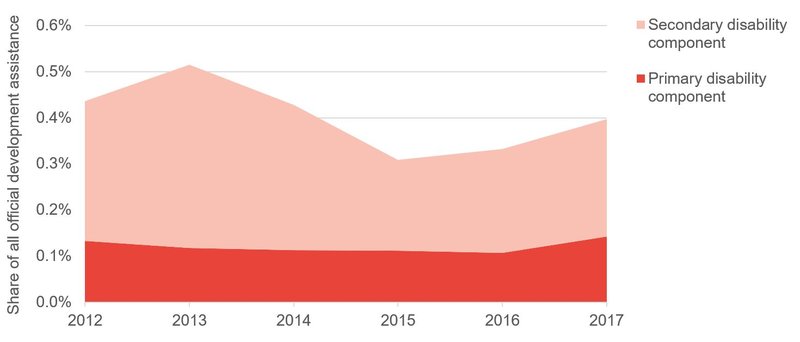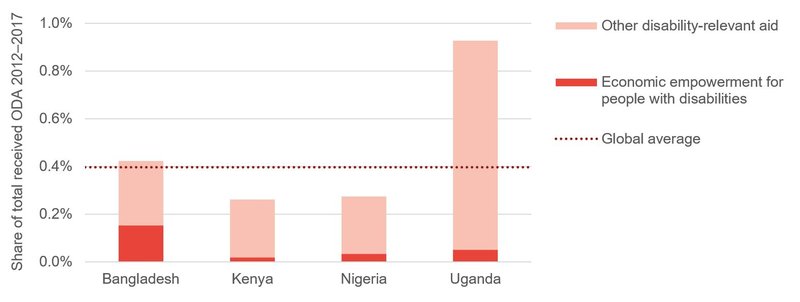How well is aid targeting disability?
The World Health Organization estimates that 15% of people worldwide have a disability. [1] People with disabilities in developing countries face significant challenges, both in terms of increased risks (of poverty and social exclusion, for example) compared with other populations, and unique burdens such as the costs of care. [2] One key mechanism for improving the living standards of people with disabilities is international aid, known as official development assistance (ODA).
In the upcoming release of 2018 ODA data (in December 2019), the Organisation for Economic Co-operation and Development’s Development Assistance Committee (OECD DAC) will introduce a mechanism for monitoring aid that is ‘disability relevant’ – earmarked for the empowerment and inclusion of people with disabilities . [3] This ‘disability marker’ will ask donors to report whether empowering or promoting inclusion of people with disabilities is the primary or secondary purpose of an aid project. However, the mechanism will be applied only from 2018 onwards; and it is difficult to quantify historical ODA targeted to assist and empower people with disabilities based on existing data.
What we did
Development Initiatives (DI) has developed a keyword methodology that identifies international aid projects with policy components relevant to people with disabilities, so that we can understand how much ODA has been spent on such projects based on current and historical data. The methodology applies multiple sets of keywords and phrases to project records to identify those targeted directly or indirectly at people with disabilities.
Our methodology matches that which the OECD will bring in, categorising aid projects according to whether they have a primary or a secondary disability component. It further classifies disability-relevant projects according to their particular focus on one or more of two areas:
- Inclusion and empowerment projects have a focus on ensuring people with disabilities are included in benefits on an equal basis to people without disabilities.
- Economic empowerment projects are a subset of inclusion and empowerment projects that have the deliberate purpose of improving employment opportunities and rights for people with disabilities.
Projects that don’t focus on these areas are classified as ‘other’.
What we found
Our analysis suggests that since 2012, just 0.1% of all international aid has been allocated to projects with a primary disability component (Figure 1). Even when we included projects with a secondary objective of assisting or empowered people with disabilities, spending totalled between 0.3% and just over 0.5% each year. The total volume of all disability-relevant aid in 2012 was $593 million; by 2017 this rose to US$750 million.
Figure 1: Globally, ODA with a disability-relevant component has formed less than 0.6% of all aid since 2012

Source: Development Initiatives based on OECD DAC Creditor Reporting System.
Aid targeted at including and empowering people with disabilities made up less than a fifth (16%) of all disability-relevant aid between 2012 and 2013; this rose significantly to 28% between 2016 and 2017 (Figure 2).
Figure 2: Globally, 28% of disability-relevant aid between 2016 and 2017 had the purpose of inclusion and empowerment

Source: Development Initiatives based on OECD DAC Creditor Reporting System.
How we are using this data
DI is working with Sightsavers as part of the Inclusive Futures initiative , funded by UK aid and working to ensure people with disabilities are able to represent themselves and make their own decisions. As part of its work, the programme aims to create and test innovative approaches to improve the long-term economic empowerment and inclusion of people with disabilities in Bangladesh, Kenya, Nigeria and Uganda. Using the keyword methodology, we have been able to quantify the level of disability-relevant aid received by these countries. Between 2012–2017, the proportion of disability-relevant aid received was 0.4% in Bangladesh and 0.9% in Uganda – meeting or exceeding the global average of 0.4%; however in Kenya and Nigeria the proportion received was 0.3%, significantly below the global average.
Since 2012, aid for the purpose of economically empowering people with disabilities has made up less than 10% of disability-relevant aid received by Kenya, Nigeria and Uganda. Bangladesh on the other hand saw over one third of disability-relevant aid with the purpose of economic empowerment of people with disabilities (Figure 3).
Figure 3: Uganda has received double the global average share of disability-relevant aid, but Bangladesh has received the highest share targeted to economic empowerment of people with disabilities

Source: Development Initiatives based on OECD DAC Creditor Reporting System.
Our findings indicate that since 2012, in most cases, an individual donor has contributed the majority of disability-relevant aid to each country. For example, in Kenya 52% of disability-relevant contributions were made up by the US alone; in Bangladesh the largest donor was Canada, accounting for 42% of the total. The largest donor of disability-relevant aid to Nigeria and Uganda has been the UK, contributing 50% and 69% of the total respectively.
Next steps
Starting with data for 2018, the OECD DAC’s ODA records will include a marker for monitoring aid that has a purpose relevant to the empowerment and inclusion of people with disabilities; however, it’s likely to take time for donors to start reporting to the marker comprehensively. The marker will identify projects with the purpose of including and empowering people with disabilities, however it will not include other assistance, such as special needs educational initiatives and assistive technologies. This means that even a partially complete picture of the scale of disability-relevant aid will require several years of reporting to fully develop.
DI’s keyword methodology will allow for a close comparison between our findings and the new OECD DAC marker, supplement its analysis where gaps exist, and allow for improved analysis of historical trends. This data, combined with the disability marker, is the first step towards understanding how well ODA is being targeted to assist and empower people with disabilities. It will also be key for tracking aid delivery over time and ensuring that the needs of vulnerable people are better met.
Notes
- 1 World Health Organization, 2011. World Report on Disabilities. Available at: https://www.who.int/disabilities/world_report/2011/report.pdf
- 2 Department for International Development, 2018. Global Disability Summit 2018: research and evidence reports. Available at: https://www.gov.uk/government/collections/global-disability-summit-research-and-evidence-reports
- 3 DAC Working Party on Development Finance Statistics, 2019. Handbook for the marker for the inclusion and empowerment of persons with disabilities. Available at: http://www.oecd.org/officialdocuments/publicdisplaydocumentpdf/?cote=DCD/DAC/STAT/RD(2019)1/RD1&docLanguage=En
Related content
Disability data in developing countries: opportunities to support inclusion
DI is working as part of the Inclusion Works consortium to improve the quality and use of disability data in Bangladesh, Kenya, Nigeria and Uganda.